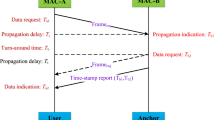Abstract
This paper focuses on time of arrival (TOA) measurement for wireless personal area network (WPAN) under the circumstances that dense multipath and non-line of sight (NLOS), which exploits a non-coherent receiver for millimeter wave (mm-Wave) pulses. For the localization enhancement, an improved statistics fingerprint analysis (SFA) method is presented for energy-assisted TOA estimate and the ranging error mitigation using artificial neural network (ANN) by fourth order cumulants (FOCs) technique. The corresponding mean absolute error (MAE) is utilized as a measurement to access the performance of the developed method. Simulation results indicate SFA can outperform TOA estimation scheme significantly proposed in WPAN previously, show that SFA can effectively enhance the accuracy of TOA estimates evidently. The advantages of SFA such as low complexity implementation, fast convergence, high accuracy, etc. make it an attractive positioning method in WPAN compared with a coherent receiver.











Similar content being viewed by others
References
Chu, Y., He, L., & Yao, F. (2016). An improved localization algorithm of taylor series expansion search target. Optik, 127(19), 8070–8075. https://doi.org/10.1016/j.ijleo.2016.05.084
Li, S., Liu, K., & Xiao, L. (2014). Fleet algorithm for X-ray pulsar profile construction and TOA solution based on compressed sensing. Optik, 125(7), 1875–1879. https://doi.org/10.1016/j.ijleo.2013.10.032
Kang, Z., He, H., Liu, J., Xin, M., & Gui, M. (2018). Adaptive pulsar time delay estimation using wavelet-based RLS. Optik, 171, 266–276. https://doi.org/10.1016/j.ijleo.2018.05.118
Miorandi, D., Sicari, S., Pellegrini, F. D., & Chlamtac, I. (2012). Internet of Things: Vision, applications and research challenges. Ad Hoc Networks, 10(7), 1497–1516. https://doi.org/10.1016/j.adhoc.2012.02.016
Sun, W. F., Wang, Z., Ma, H. Y., Zhao, L., & LI, Q.R. (2012). Key technologies and typical military application of IoT. Internet things technol. https://doi.org/10.3969/j.issn.1002-137X.2010.06.001
Chatzigiannakis, I., Drude, J.P., Hasemann, H., & Kröller, A. (2014). Developing smart homes using the Internet of Things: How to demonstrate your system, International Conference on Distributed, Ambient, and Pervasive Interactions, Cham, Switzerland: Springer, 2014: 415-426.
Uckelmann, D., Harrison, M., & Michahelles, F. (2011). Architecting the Internet of Things. Springer.
Swan, M. (2012). Sensor mania! The Internet of Things, wearable computing, objective metrics, and the quantified self 2.0, Journal of Sensor and Actuator Networks. 1(3), 217–253. https://doi.org/10.3390/jsan1030217
Hazra, R., & Tyagi, A. (2014). A survey on various coherent and non-coherent IR-UWB receivers. Wireless Personal Communications., 79(3), 2339–2369. https://doi.org/10.1007/s11277-014-1988-4
Zhang, H., Cui, X., & Gulliver, T. A. (2011). Threshold selection for ultra-wideband TOA estimation based on skewness analysis. Springer-Verlag Lecture Notes in Computer Science., 6905, 503–513. https://doi.org/10.1007/978-3-642-23641-9_40
Guvenc, I., & Sahinoglu, Z. (2005). Threshold selection for UWB TOA estimation based on kurtosis analysis. IEEE Communications Letters., 9(12), 1025–1027. https://doi.org/10.1109/LCOMM.2005.1576576
Zhang, H., Cui, X., & Gulliver, T. A. (2012). Remotely-sensed TOA interpretation of synthetic UWB based on neural networks. EURASIP Journal on Advances in Signal Processing., 185(1), 13. https://doi.org/10.1186/1687-6180-2012-185
Feng, W., Zhi, T., & Sadler, B. (2012). Weighted energy detection for noncoherent ultra-wideband receiver design. IEEE Transaction on Wireless Communications. 10 (2), 710–720. https://doi.org/10.1109/TWC.2010.120310.101390
Mendel, J. (1991). Tutorial on higher-order statistics (spectra) in signal processing and system theory: Theoretical results and some applications. Proceedings of the IEEE., 79(3), 278–305. https://doi.org/10.1109/5.75086
Ding, Y., Wang, Y., & Zhou, D. (2017). Mortality prediction for ICU patients combining just-in-time learning and extreme learning machine. Neurocomputing, 281, 12–19. https://doi.org/10.1016/j.neucom.2017.10.044
Hou, C., Nie, F., Zhang, C., Yi, D., & Wu, Y. (2014). Multiple rank multi-linear SVM for matrix data classification. Pattern Recognition., 47(1), 454–469. https://doi.org/10.1016/j.patcog.2013.07.002
Wang, Y., Dong, Z., Li, Z., & Ding, S. X. (2017). Unbiased minimum variance fault and state estimation for linear discrete time-varying two-dimensional systems. IEEE Transactions on Automatic Control, 62(10), 5463–5469. https://doi.org/10.1109/TAC.2017.2697210
Liang, X., Zhang, H., & Gulliver, T. A. (2016). Energy detector based time of arrival estimation using a neural network with millimeter wave signals. KSII Transactions on Internet and Information Systems, 10(7), 3050–3065. https://doi.org/10.3837/tiis.2016.07.010
Zafar, A., & Hong, K. (2017). Detection and classification of three-class initial dips from prefrontal cortex. Biomedical Optics Express., 8(1), 367–383. https://doi.org/10.1364/BOE.8.000367
Liang, X., Zhang, H., Lu, T., & Gulliver, T. A. (2017). Energy detector based TOA estimation for MMW systems using machine learning. Telecommunication Systems., 64(2), 417–427. https://doi.org/10.1007/s11235-016-0182-2
Liang, X., Zhang, H., Gulliver, T. A., Fang, G., & Ye, S. (2017). An improved algorithm for through-wall target detection using ultra-wideband impulse radar. IEEE Access., 7(5), 22101–22118. https://doi.org/10.1109/ACCESS.2017.2761771
Oh, D., Kim, S., Yoon, Y. H., Chong, J. W., & Daegun, O. (2013). Two dimensional ESPRIT-like shift-invariant ToA estimation algorithm using multi-band chirp signals robust to carrier frequency offset. IEEE Transactions on Wireless Communications., 2(7), 3130–3139. https://doi.org/10.1109/TWC.2013.060413.112013
Stoica, P., Hao, H., & Jian, L. (2009). New algorithms for designing unimodular sequences with good correlation properties. IEEE Transactions on Signal Processing., 57(4), 1415–1425. https://doi.org/10.1109/TSP.2009.2012562
Hao, H., Stoica, P., & Jian, J. (2009). Designing unimodular sequence sets with good correlations, including an application to MIMO radar. IEEE Transactions on Signal Processing., 57(11), 4391–4405. https://doi.org/10.1109/TSP.2009.2025108
Acknowledgements
The authors declare that there is no conflict of interest regarding the publication of this manuscript. This work was supported by the Nature Science Foundation of China under Grant No. 41527901.
Author information
Authors and Affiliations
Corresponding author
Ethics declarations
Conflict of interest
The authors declare no potential conflicts of interest with respect to the research, authorship, and/or publication of this article.
Data Availability
The data used to support the findings of this study are available from the corresponding author upon request.
Additional information
Publisher's Note
Springer Nature remains neutral with regard to jurisdictional claims in published maps and institutional affiliations.
Rights and permissions
About this article
Cite this article
Liang, X., Zhu, W. & Deng, J. An Improved Statistics Fingerprint Analysis Method for Time Delay Estimation in Multipath NLOS Environment. Wireless Pers Commun 123, 1855–1869 (2022). https://doi.org/10.1007/s11277-021-09217-1
Accepted:
Published:
Issue Date:
DOI: https://doi.org/10.1007/s11277-021-09217-1




